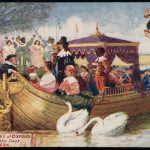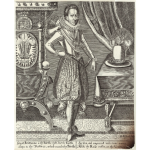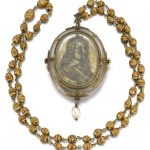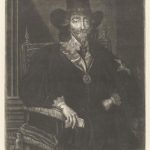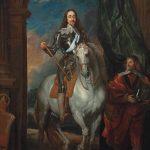Charles I. The younger, surviving son of James I and Anne of Denmark, Charles became heir to the throne on the death of his brother Henry in 1612. Charles inherited his father’s belief in the ‘Divine Right of Kings’ and became the greatest of all British royal art patrons and collectors. His dismissal of Parliament and personal rule, however, along with his imposition of taxes and attempts to impose religious uniformity led eventually to civil war. He was defeated and tried on the charge that he ‘traitorously and maliciously levied war against the present Parliament and the people therein represented’, and he was executed outside the Banqueting House, Whitehall, on 30 January 1649. Reference: The National Portrait Gallery
CHARLES I at OXFORD. The Happy Days 1636. Publisher: Raphael Tuck & Sons (English, 1886–1960) English about 1907
Chromolithograph on card stock.
Front: Oilette. OXFORD PAGEANT OFFICIAL POSTCARD. Back: divided. Mint. “OXFORD PAGEANT.” Ser. III. Raphael Tuck & Sons’ “OILETTE” [Regd.] Postcard 9518. ART PUBLISHERS TO THEIR MAJESTIES THE KING & QUEEN. Direct from the original picture by A. LUDOVICI.
Reference: Museum of Fine Arts Boston
King Charles I by Renold or Reginold Elstrack (Elstracke) line engraving, early 17th century 7 1/2 in. x 6 1/8 in. (190 mm x 154 mm) paper size
Reference: The National Portrait Gallery
ENGLISH, SECOND HALF 17TH CENTURY Pendant with a Portrait of Charles I with the Royal cipher for Charles I to the reverse within a wreath of diamond chips rock crystal, with a gilt copper relief, gold filigree, and diamonds, with pearl pendant, on a partially enamelled gold chain pendant: 7.5cm., 3in. 55cm., 21⅝in. overall, suspended
From the time of the king’s execution in 1649 relics were secretly commissioned for his devoted followers. Memorial portraits of the Martyred king were inspired by the portraits of Charles I after John Roettiers (1631-1703) and Thomas Rawlins and of course the triple portrait by Van Dyck. Various exhibitions including such relics were curated in the late 19th and into the 20th century including that at the Memorial Hall, Manchester in 1883, Huddersfield in 1883, Cambridge in 1911, at Lansdowne House, London in 1930, and most recently the Royal Academy in 2018.
Sold for 9,375 GBP at Sotheby’s i 2019
Portrait of King Charles I entitled ‘The true Effigies of His Majestie King Charles the first, As he Sate in the Pretended High Court of Justice, Anno. 1648. Done from the Originall at Oxford.’
ca. 18th century (printed) Fielding, Copley, born 1787 – died 1855 (painter) Faber, John the younger (engraver) Faber, John I (engraver) mezzotint
Reference: © Victoria and Albert Museum
After Sir Anthony van Dyck, late 17th Century Portrait of King Charles I, bust-length, in a scarlet slashed doublet oil on panel 19.6 x 16.2cm (7 11/16 x 6 3/8in).
Sold for £ 5,062 inc. premium at Bonham’s in 2019
Follower of Sir Anthony van Dyck King Charles I with Monsieur de St. Antoine inscribed ‘Charles 1st, by Vandyck, He is attended by His Equerry Monsr; de St Antoine, a Knight of Malta.’ (upper left) oil on canvas 122¼ x 99 3/8 in. (310.5 x 252.5 cm.)
Sold for GBP 97,875 at Christie’s in 2013
